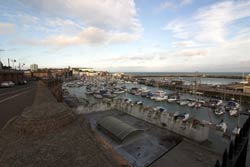Tamron SP AF 11-18mm f/4.5-5.6 DiII LD Aspherical (IF)
This lens is Tamron’s entry into the ultra-wide zoom category lenses that are designed for cropped sensors only. Tamron’s designation for this is the DiII suffix. Ultra wide zooms of this type are a fairly new phenomenon so we take a look here at how it performs.
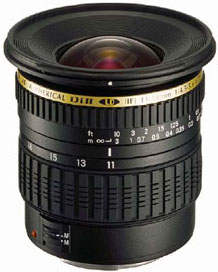 Specifications
Specifications
- Focal length 11-18mm
- Aperture f/4.5-5.6
- Angle of view 103-75° (APS-C size)
- Filter size / type 77mm
- Construction Elements/groups 15 elements in 12 groups
- Focusing type Internal
- Closest focus 0.25m
- Weight 0.375kg
- Dimensions (Dia x length) 82.2x78.6mm
- Mounts available Canon, Nikon, Minolta,
- Tripod bush No
- Price £459.99
Build and Handling
This lens is extremely small and lightweight for the type which is probably due to the fact it only needs to cover an APS-C sized sensor with it’s image circle. It comes boxed with the documentation and a petal shaped hood is supplied. The zoom ring, first on the barrel going forward from the mount, is marked at 11, 13, 15 and 18mm and three quarters of the 25mm ring is covered in a rubber-ribbed grip. The remainder of the barrel is occupied with the manual focus ring, again part covered with ribbing of a slightly different tactile feel. Those mounts requiring an AF/MF switch have it fitted in the usual place.
The zoom ring is nicely torqued although the MF ring was a little sloppy once the AF motor was disengaged. When AF is engaged it does not feel as though the focussing should be over-ridden although it was possible but jerky. Autofocus proved accurate but was a little slow and did produce a quietly laboured sound. Zooming extends the lens’ length by less than 5mm.
Optical Quality
The use of moulded aspherical glass manufactured with newer processes and low dispersion elements, along with modern computer aided design have made this type of lens possible without breaking the bank. The control of distortions is, to say the least, admirable and not detectable with the naked eye. Chromatic aberrations, the cause of purple fringing in digital images, are well controlled in the centre of the images but the corrections fail somewhat towards the edges. Unfortunately, the same thing happens with the resolution figures, which display a wide difference between the centre and the edge of the frame. The centre is very good however, and it is a pity that the edge performance harks back to the old days of lens design. Contrast and colour rendition are nice and go a long way in overcoming the resolution shortcomings, producing an overall pleasing image.
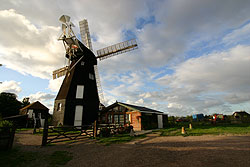 Dramatic landscapes and architectural shots are brought into the domain of the cropped sensor photographer. Canon 300D, 1/90sec at f/11 and 12mm | 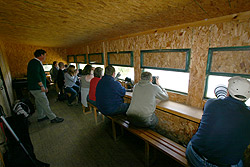 Confined space photography is also possible with this lens but beware that the lens hood will shield an on-board flash. Canon 300D, 1/60sec at f/10 with built in flash. Set at 11mm. |
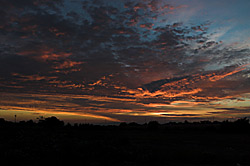 | Expansive skies that lost their true drama before this type of lens was brought in to overcome the crop factor now return to their full glory. Canon 300D. 1/800sec at f/8 and 16mm |
Click on each comparision photo below to view full size versions
Below is our lens test data. To find out how to use these graphs look at this article: How we test lenses
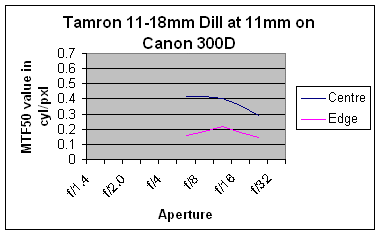
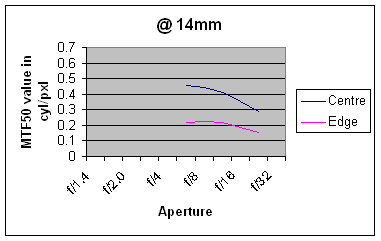
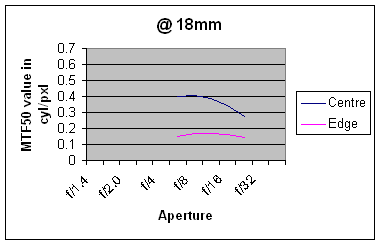
Verdict
This lens goes a long way in overcoming the biggest drawback of the cropped digital sensor, that of wide-angle coverage. The light weight, which possibly compromises build quality slightly, reduces the penalty incurred by carrying extra lenses. The only disappointment was the quality drop-off towards the edges of the image, but many compositions can cope with the anomaly. The front element does not rotate during use, making the use of filters, which are the common 77mm size, easy to use. Filter systems need to be 100mm or more though in order to cope with the wide angle of view.
In summary, the positive points of the Tamron SP AF 11-18mm f/4.5-5.6 DiII LD Aspherical (IF) are
![]() Good control of distortions
Good control of distortions
![]() Good contrast and colour rendition
Good contrast and colour rendition
![]() Lightweight and comfortable in use.
Lightweight and comfortable in use.
Negative points are:
![]() Sloppy manual focus
Sloppy manual focus
![]() Fall-off in quality towards the edges.
Fall-off in quality towards the edges.
Check the latest price of the Tamron 11-18mm f.4.5-5.6 DiII here
Test by Ian Andrews www.wildaboutkent.co.uk
Add your message
Please login here or if you've not registered, you can register here. Registering is safe, quick and free.
photodo Stats
428 MTF tests
74 in-depth photodo reviews
100+ users join each day
Help the lens community by reviewing or rating a lens today via our lens search
Latest Lens Reviews
- Chinon 28mm f/2.8 Vintage Lens Review
- Canon EF 70-200mm f/4L IS II USM Lens Review
- Samyang AF 85mm f/1.4 EF Review
- Sigma 70mm f/2.8 DG Macro Art Review
- Samyang AF 24mm f/2.8 FE Review
- Meike 50mm f/1.7 Review
- Tamron 70-210mm f/4 Di VC USD Review
- Lensbaby Burnside 35mm f/2.8 Review
- Asahi Super Takumar 50mm f/1.4 Review
- Asahi Super-Multi-Coated Takumar 135mm f/3.5 Review
